Contents
Blackberry “Thornless Evergreen” has been known for 90 years. This variety is actively grown by farms in America and Europe, although it does not belong to large-fruited ones. His description scared away many of our gardeners by pointing to late ripening, but in the middle lane he has time to fully ripen, because he is in no hurry to drop leaves and is not afraid of frost. He has a lot of positive qualities and deserves to take a closer look at him.
Description of the blackberry variety
The European prickly blackberry “Evergreen” has been known for a long time, then its clone in America gave a thornless mutation that could not help but attract attention, and already 1926 was marked by the appearance of a new variety “Thornless Evergreen”.
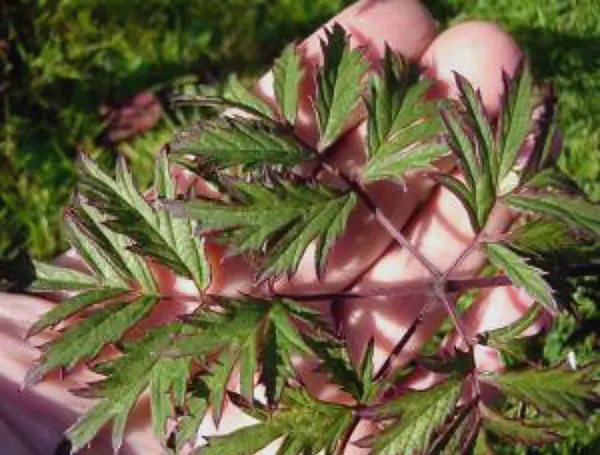
This is a surprisingly powerful bush with creeping shoots, which have a five-sided shape at the base. At the beginning of the growing season, they are green, and towards the end of the growing season they turn slightly red. Thornless shoots grow up to 6 meters and look very decorative – green leathery leaves have an elegant carved shape, many white or slightly pinkish flowers in the middle of summer, and then ripening fruits that change their color from red to black cannot go unnoticed. Some amateurs have already organized a hedge from such bushes. The bushes of this variety are also distinguished by the fact that they have more berries than green mass.
The bush does not give root shoots, but if the root is damaged by careless loosening, then thorny shoots can grow, they must be cut ruthlessly so as not to lose such a convenient dignity as thornlessness.
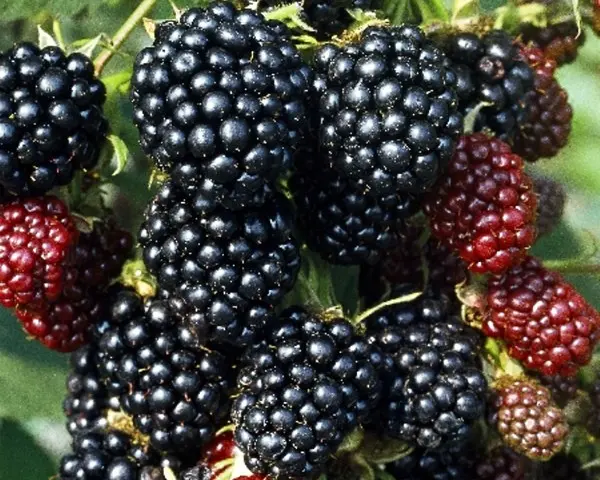
Fruiting begins in the second decade of August and lasts until mid-September, berries are picked 2-3 times a week.
Due to the fact that this blackberry is not afraid of frost (and the characteristics of the variety indicate that the shoots can survive frosts of -30 degrees), the bushes do not lose their leaves even for the winter, which is reflected in the name of the Evergreen variety. This allows you not to rush to cover the shoots, but first to collect a fully ripe crop. Our climate can be uncomfortable even for evergreen berry crops, so shoots right with leaves need to be rolled up and hidden under covering material, as is usually done with blackberries or grapes in our area. And in the spring, when the earth only thaws, and the whole garden will still gape with blackness, and the blackberry bush will already please with its green, albeit last year, leaves.
Berries differ in abundance and fresh sweet and sour taste. They are small, comparable more with raspberries than with the fruits of thornless blackberries, weighing from 3 to 5 grams. But from one bush they are collected at least 10 kg, and sometimes more. The brushes are large, branched, in one brush there can be from 25 to 70 berries. They are sour at the stage of technical maturity, then, with the onset of full ripening, the sourness practically disappears, the taste becomes almost unexpressed sweet. Chilled berries can be stored for several days, they perfectly tolerate transportation.
Video “Blackberry seedlings Thornless Evergreen”
This video will introduce you to the variety description that accompanies the packaging of purchased blackberry seedlings.
Advantages and disadvantages
The blackberry of this variety has undoubted advantages, for which it is grown not only in the country to provide tasty vitamin berries to your family, but also in farm fields for commercial purposes. Landing and care are somewhat facilitated due to the absence of spikes. It is also convenient that the bush does not give root shoots, the fight against which in raspberries, for example, takes a lot of time and effort from the gardener.

The blackberry bush is very decorative due to the beautiful carved leaves and powerful shoots in the spring, and the rest of the time due to the number of flowers and fruits that clearly exceed the green mass of the plant. Its amazing yield is due to the large number of medium-sized berries.
It is easy to collect fruits – they are compact, there are many berries on one brush, there are no thorns, so it does not take too much time. The berries are easily removed from the stalk, after cooling they are transported without loss, stored for several days, while they do not flow, they are not even deformed. They are suitable for fresh consumption and for processing, are part of desserts and sour-milk dishes.
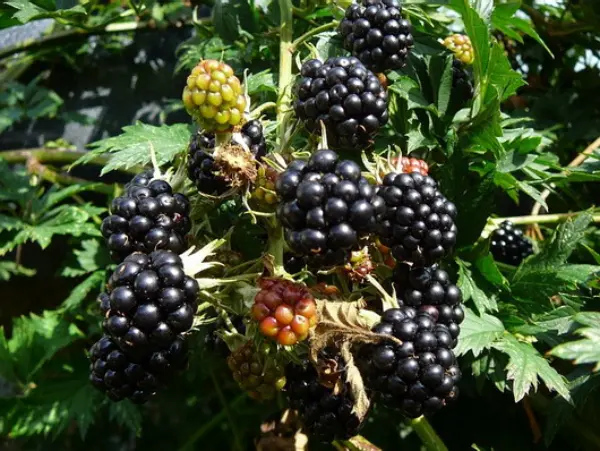
The Thornless Evergreen variety is not afraid of frost, fully ripens in early autumn, when there are no such berries anymore, stretched fruiting is very convenient for long-term (4 or even 5 weeks) consumption of fresh berries. Frost resistance, immunity to fungal and viral diseases facilitate the care of the plant.
But later and prolonged maturation, some tend to consider a disadvantage. Those who want to plant Thornless Evergreen on their plot for the sake of a large harvest need to know that the maximum falls on about the fifth year of growth. The first couple of years there are few berries. You need to show care and attention to get a good harvest a few years after planting.
Care Basics
Thornless Evergreen is not a new hybrid that can survive drought and grow in any soil. He needs a lot of moisture and fertilizer, he will grow quickly, bear fruit well on neutral soil rich in humus. The soil should be light enough so that air enters the roots and the water does not stagnate. You also need an open, unshaded place so that the berries ripening in early autumn receive the right amount of solar energy.
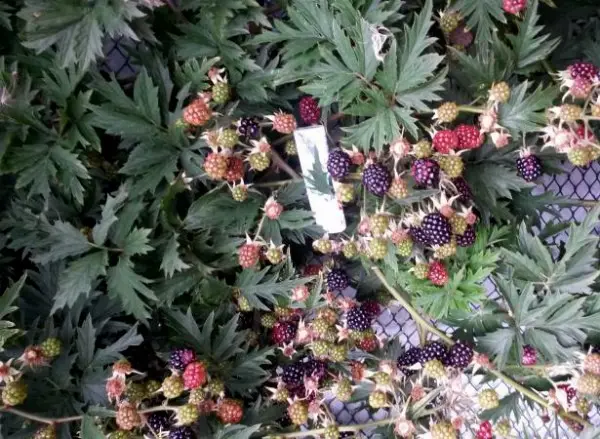
Seedlings need to choose strong, not overdried, the roots must also be alive, moist. It is better to plant on the site in the spring. In autumn, seedlings usually take root well, but the next year they try to bloom, and this does more harm than fruit.
A pit is dug out with a diameter and depth of at least 50 cm, compost or humus, complex mineral fertilizers (with an emphasis on nitrogen), and wood ash are placed in it. If the soil is more acidic than necessary, lime or dolomite flour must be added. All this is mixed with the ground, laid out in a slide at the bottom of the pit, covered with a small layer of earth from above, and only then the roots are placed, straightened and covered with earth. There must be a layer of earth between the roots and fertilizers, otherwise a burn is possible, which will retard growth for a long time.
The earth around the bush needs to be tamped, watered abundantly. The root neck should be slightly above ground level. Then the ground around is mulched with peat, compost or straw, the shoots are cut to 30 cm.
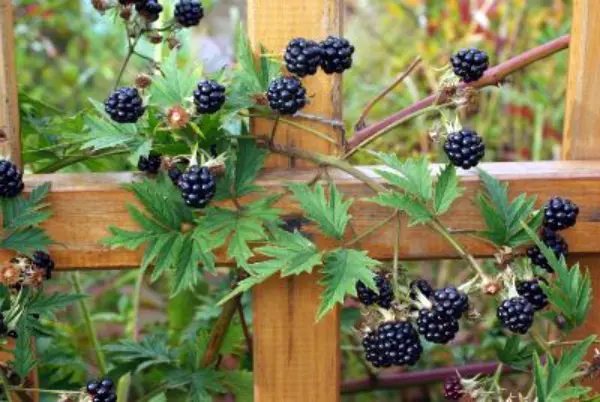
Since creeping shoots will grow very long, it is worth considering a trellis. Usually two supports are installed, a wire is pulled between them at a height of 0,5 m, 1 m, 1,5 m (1,7 m). Between the two upper ones they braid or wrap long shoots on each of the wires. They grow long and beautiful, so you can come up with some other shape. The main thing is that the shoots do not touch the ground and do not shade each other, they must be easily permeable to air and light.
You can create the most inconceivable decorative figures from shoots, but you should remember about the fruits, they will have to be collected two or three times a week, and this should be convenient.
Pruning is carried out, as with all traditional blackberry varieties, in autumn and spring. In autumn, you need to cut out completely those shoots that bear fruit, shorten the young ones a little (by a quarter). And in the spring they carry out sanitary pruning if necessary – they remove those shoots that suffered in the winter. If too many replacement shoots grow (this can be discussed in the 5th year or later), then normalizing pruning is carried out, as many as they consider necessary are left, and the weaker ones are removed. Some gardeners shorten the lashes in the summer to get more fruit twigs, which means more fruit. But with this variety, there will obviously be no shortage of berries.

With the onset of flowering, as well as during the formation of ovaries, you can apply top dressing. Usually complex mineral fertilizers are bred, but now with an emphasis on potassium, and the bushes are watered. Some people prefer to water the plants with a solution of slurry (it needs to be diluted 10 times) or bird droppings (it needs to be diluted 20 times).
Water regularly depending on the weather, dry summers may require weekly watering, but water should not be allowed to stagnate at root level. Although this variety is resistant to fungal diseases, spores fly everywhere, if they create the appropriate conditions, the disease will not take long. It is necessary to loosen the ground around the bushes, but if the roots are damaged, then prickly offspring will grow, which then will definitely need to be cut out. It is imperative to dig aisles, plant residues should not lie there, all weeds, fallen leaves, cut shoots must be removed in time.
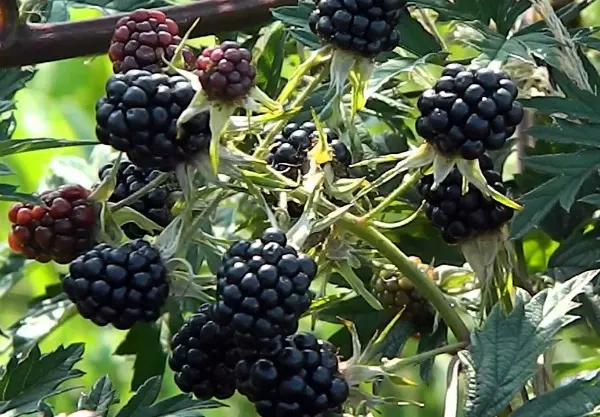
Thornless Evergreen propagates, like any representative of dewdrops (varieties with creeping shoots), by rooting cuttings and young shoots. Cuttings are taken in the fall, when young shoots are shortened, the branches are cut so that they have a pair of buds on them, and rooted. In summer, a young shoot is chosen, dug in to a depth of 20 cm, pinned with something or then pressed down on top of the ground. The end of the escape must be on the surface. The dug part is watered all summer, and by autumn there will already be several roots. You can cut the branch into rooted cuttings, or you can leave everything as it is until spring, and then transplant it to a permanent place of growth. To speed up the process of root germination, you can lightly scratch the bark under the kidneys in the part that will be underground.
Caring for the Thornless Evergreen variety is similar to caring for a regular blackberry, but it is somewhat lighter and the result is more pleasant – a lot of berries and no thorns.
Video “Pruning thornless blackberries in summer and autumn”
This video shows the correct summer pruning of garden thornless blackberries. You will learn why it is carried out and how best to do it.









